 |
JAVA: AddressBook Case Study Using Sevlets |
| << JAVA: Session Tracking 2 |
| Java Server Pages 1 >> |
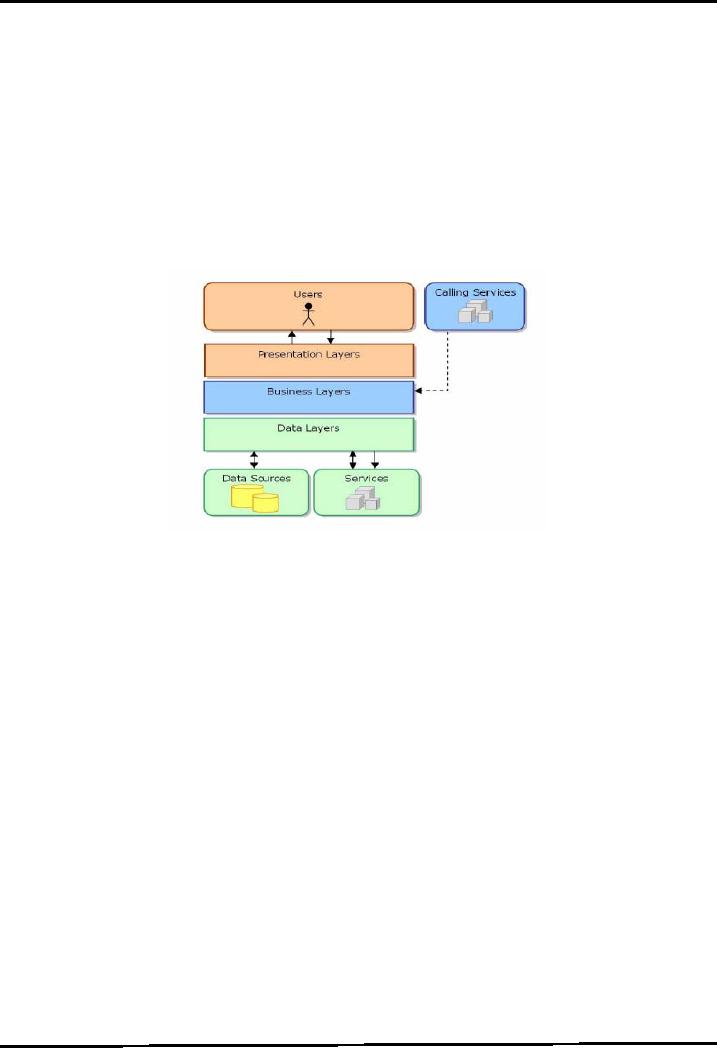
Web
Design & Development CS506
VU
Lesson
33
AddressBook
Case Study
Using
Sevlets
Design
Process
In
this handout, we will
discuss the design process of a simple
address book. A step by step
procedure of
creating
a simple address book is
given below.
Layers
& Web Application
As
discussed previously, normally
web applications are
partitioned into logical layers.
Each layer performs
a
specific functionality which
should not be mixed with
other layers. For example
data access layer is
used
to
interact with database and we do
not make any direct calls to
database from the presentation
layer.
Layers
are isolated from each
other to reduce coupling between them
but they provide interfaces
to
communicate
with each other.
Simplified
view of a web application
and its layers
-Presentation
Layer
Provides
a user interface for client
to interact with application.
This is the only part of
application
visible
to client.
-Business
Layer
The
business or service layer implements the actual
business logic or functionality of the
application.
For
example in case of online
shopping systems this layer
handles transaction management.
-
Data Layer
This
layer consists of objects that
represent real-world business objects
such as an Order,
OrderLineItem,
Product, and so on. It also encapsulates
classes which are used to
interact with the
data
providing services such as
databases, other web
services etc.
In
our case study of address
book, we will also try to
make use of the layered
architecture. We will create a
separate
layer for working with data,
and our presentation and business logic
will be merged into servlets.
It
means
that we will not have
separate layers for presentation and
business rather one layer (formed
by
servlets)
will do the job of both presentation and
business logic. The extent
to which you divide
your
application
into layers depends upon the
size of the application and
some other factors such as
scalability,
portability
etc.
Step
1
Create
a database (AddressBook)
Make
a table named Person
according to the figure shown below. It
has columns name,
address,
phomeNum
245
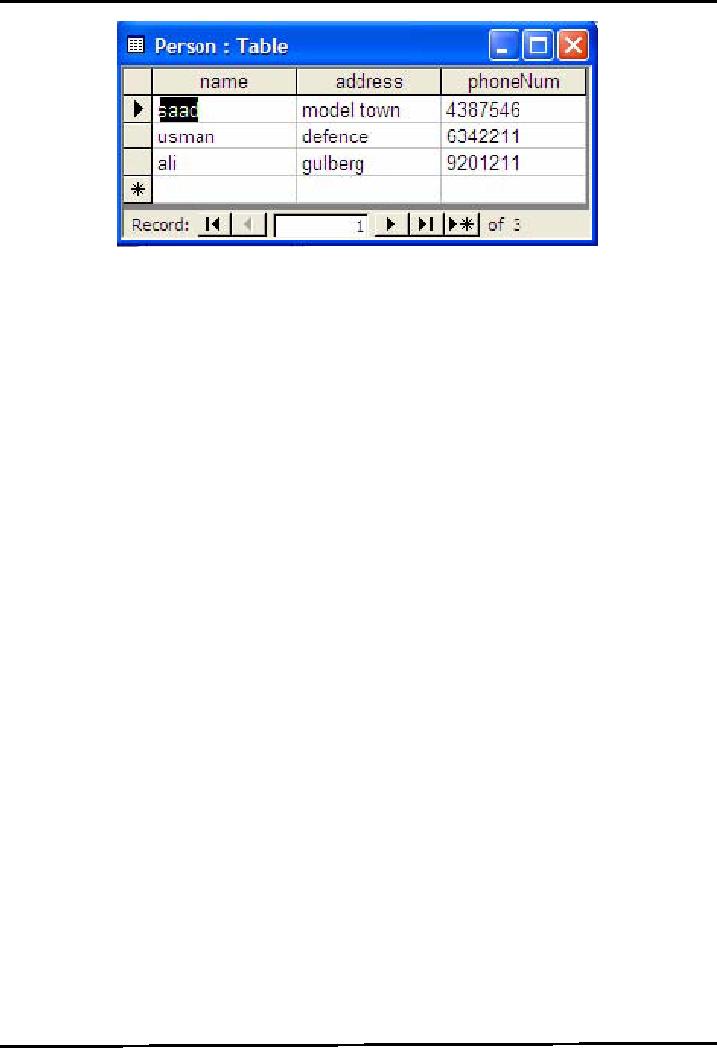
Web
Design & Development CS506
VU
Step
2
The
next step is to create a
class that can hold the
information of a single person.
Remember we have stored
the
information in the database, now
when we extract this
information from the database as a
result of some
search,
we will require some object
to store the data for that
particular person. The
PersonInfo class will
be
used
at that point to store the
retrieved data and transport it to
presentation layer. Also we extend
this
application
and add the functionality of "AddingNewContacts" in
the database. The PersonInfo
class can be
used
to transport data from front end to the
database.
Make
a PersonInfo class with the
following consideration
It
has three three attributes: name,
address, ph. No.
It
has a parameterized constructor which
takes in the above mentioned
parameters
Override
the toString() method
//File:
PersnInfo.java
public
class PersonInfo
{
String
name;
String
address;
String
phoneNum;
public
PersonInfo(String n, String a, String
pn) {
name
= n;
address
= a;
phoneNum
= pn;
}
public
String toString( ){
return
"Name: " + name + " Address: " + address
+ " Phone No: " +
phoneNum;
}
}//
end class PersonInfo
Note:
To keep the
code simple, attributes
(name, address & phoneNum)
are not declared as
private,
which
is indeed not a good
programming approach.
Step
3
Now
we will create a class that
will be used to interact
with the database for the
search, insert, update and
delete operations.
We will call it PersonDAO where
DAO stands for the "data
access object". The
PersonDAO
along with the PersonInfo
class forms the data layer
of our application. As you
can see that
these
two classes do not contain
any code related to presentation or
business logic (There is not
much of
business
logic in this application
anyway). So PersonDAO along
with PersonInfo is used to
retrieve and
store
data in this application. If at
some stage we choose to use
some other way of storing
data (e.g. files)
only
the PersonDAO class will
change and nothing else,
which is a sign of better design as
compared to a
design in
which we put every thing in
a single class.
246

Web
Design & Development CS506
VU
So,
Make a PersonDAOclass which
contains:
a
searchPerson(String name) method that
first establishes a connection to the
database and returns
PersonInfo
object after searching the information of
the specified person from
the database.
//File:
PersonDAO.java
import
java.sql.*;
public
class PersonDAO {
// method
searchPerson
public
PersonInfo searchPerson(String
sName){
PersonInfo
person = null;
try
{
Class.forName("sun.jdbc.odbc.JdbcOdbcDriver");
String
url = "jdbc:odbc:AddressBookDSN";
Connection
con =
DriverManager.getConnection(url);
String
sql = "SELECT * FROM Person
WHERE name = ?";
PreparedStatement
pStmt = con.prepareStatement(sql);
pStmt.setString(1,
sName);
ResultSet
rs = pStmt.executeQuery();
if
(rs.next( ) ) {
String
name = rs.getString("name");
String
add = rs.getString("address");
String
pNum = rs.getString("phoneNum");
person
= new PersonInfo(name, add,
pNum);
}
con.close();
}catch(Exception
ex){
System.out.println(ex);
}
return
person;
}//
end method
}
Step
4
To
find what user wants to
search, we need to give user
an interface through which
he/she can enter the
input.
The SearchPesonServlet.java will do this
job for us, It will
collect the data from the
user and submit
that
data to another class. The
SearchPersonServlet forms the part of
our presentation layer. As you
can see
that
it is being used to present a
form to the user and collect
input.
Write
SearchPersonServlet.java
Will
take input for name to
search in address
book
Submits the
request to ShowPersonServlet
//File:
SearchPersonServlet.java
import
java.io.*;
import
java.net.*;
import
javax.servlet.*;
import
javax.servlet.http.*;
public
class SearchPersonServlet
extends
HttpServlet {
protected
void processRequest(HttpServletRequest
request,HttpServletResponse
esponse)
throws
ServletException, IOException {
response.setContentType("text/html");
PrintWriter
out = response.getWriter();
out.println("<html>"
+ "<body>" +"<h1> Address
Book </h1>" +"<form
action=showperson >"
+ //
showperson is alias or
247

Web
Design & Development CS506
VU
//
url pattern of
//
ShowPersonServlet"<h2> Enter name
to
search
</h2> <br/>" +"<input
type=text name=pName /> <br/>"
+"<input type=submit
value=Search
Person />" +"</form>"
+"</body>" +"</html>"
);
out.close();
}
//
Handles the HTTP GET method.protected
void
doGet(HttpServletRequest
request,HttpServletResponse response)
throws
ServletException, IOException {
processRequest(request,
response);}
//
Handles the HTTP POST method protected
void doPost(HttpServletRequest
request,HttpServletResponse
response)
throws
ServletException, IOException {
processRequest(request,
response);
}
}
Step
5
The
data submitted by the SearchPersonServlet
will be submitted to another servlet
i.e. ShowPersonServlet,
which
will interact with the DataLayer(Business
logic processing) collects the output and show it to
the
user.
The ShowPersonServlet forms the part of
our presentation layer and
business layer. As you can
see
that
it is being used to do processing on the
incoming data and giving it to
data layer (business layer)
and
present
data/output to the user (presentation
layer)
.
Write ShowPersonServlet.java
.
Receives request from
SearchPersonServlet
.
Instantiate objects of PersonInfo and
PersonDAO class
.
Call searchPerson() method of
PersonDAOclass
.
Show results
//File
: ShowPersonServlet.java
import
java.io.*;
import
java.net.*;
import
javax.servlet.*;
import
javax.servlet.http.*;
public
class ShowPersonServlet
extends
HttpServlet {
protected
void processRequest(HttpServletRequest request,HttpServletResponse
response) throws
ServletException,
IOException {
response.setContentType("text/html");
PrintWriter
out = response.getWriter();
String
name = request.getParameter("pName");
//
creating PersonDAO object, and
calling searchPerson() method
PersonDAO
personDAO = new
PersonDAO();
PersonInfo
person = personDAO.searchPerson(name);
out.println("<html>");
out.println("<body>");
out.println("<h1>Search
Results</h1>");
248

Web
Design & Development CS506
VU
if (person !=
null){
out.println("<h3>"+
person.toString() +"</h3>"
);
}
else{
out.println("<h3>Sorry!
No records found</h3>" );
}
out.println("</body>");
out.println("</html>");
out.close();
}
//
Handles the HTTP GET method.protected
void
doGet(HttpServletRequest
request,HttpServletResponse
response)throws
ServletException, IOException
{processRequest(request,
response);}
//
Handles the HTTP POST method.protected
void
doPost(HttpServletRequest
request,HttpServletResponse
response)throws
ServletException, IOException
{processRequest(request,
response); }
} // end
ShowPersonServlet
Sequence
Diagram: Address Book (search
use case)
249
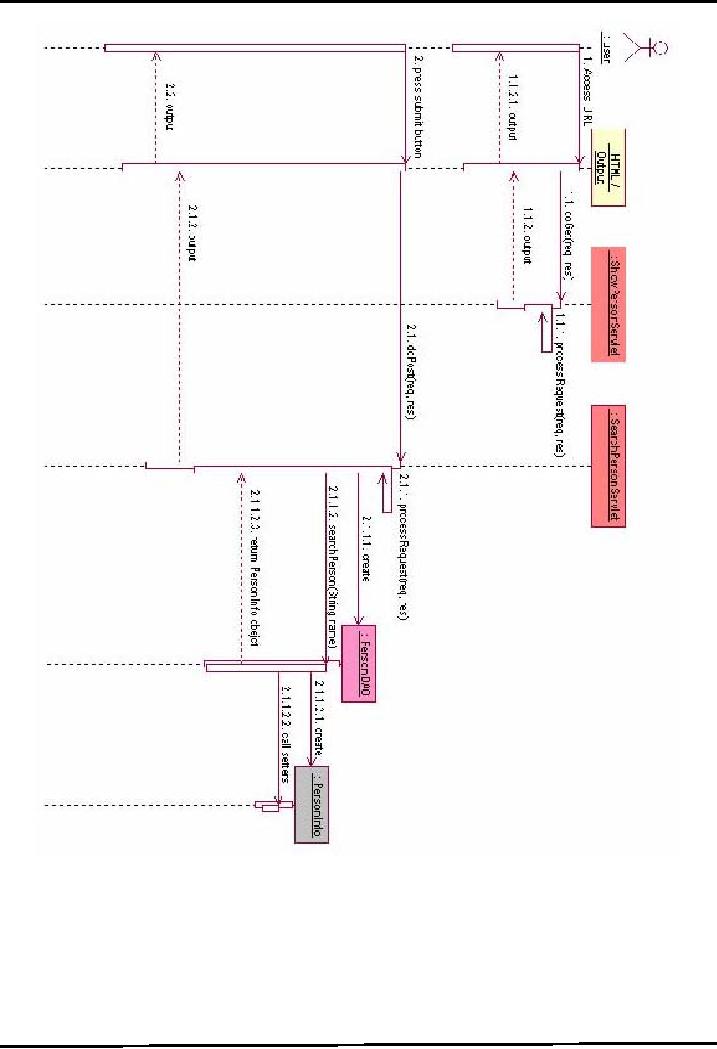
Web
Design & Development CS506
VU
Package
Many
times when we get a chance to work on a
small project, one thing we
intend to do is to put all
java
files
into one single directory
(folder). It is quick, easy
and harmless. However if our
small project gets
bigger,
and the number of files is increasing,
putting all these files
into the same directory
would be a
nightmare
for us. In java we can
avoid this sort of problem by
using Packages.
What is
a package?
In
simple terms, a set of Java
classes organized for convenience in the
same directory to avoid the
name
collisions.
Packages are nothing more
than the way we organize
files into different
directories according to
their
functionality, usability as well as
category they should belong
to. An obvious example of
packaging is
250
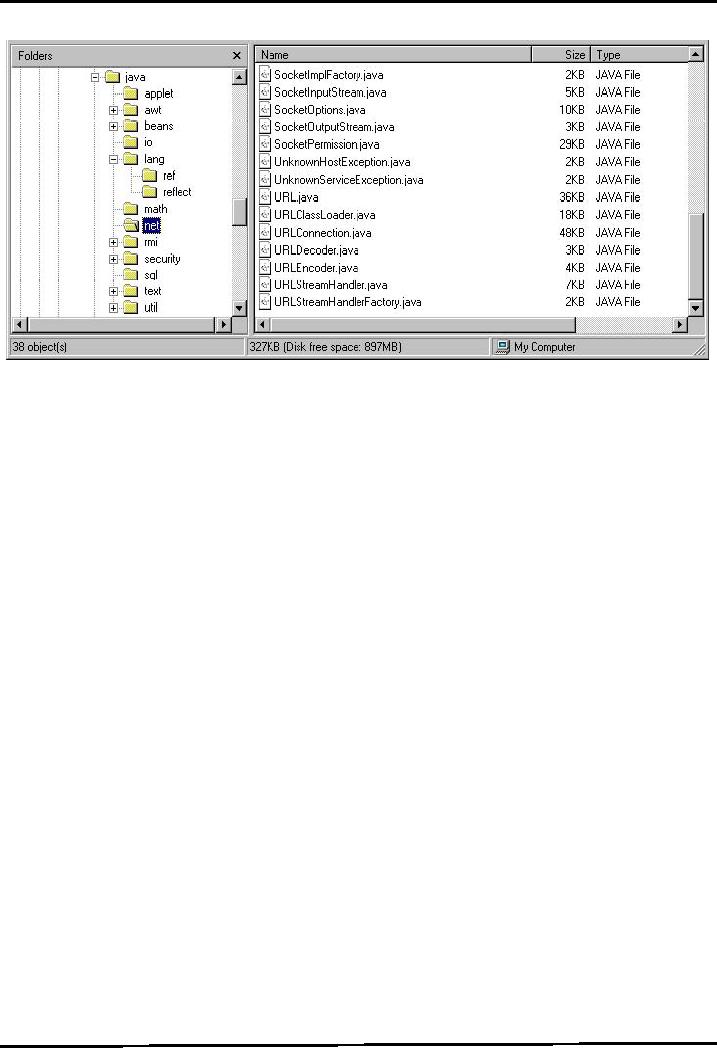
Web
Design & Development CS506
VU
the
JDK package from SUN
(java.xxx.yyy) as shown below:
Figure.
Basic structure of JDK package
Basically,
files in one directory (or
package) would have different
functionality from those of
another
directory.
For example, files in
java.io package do something related to
I/O, but files in java.net
package
give
us the way to deal with the
Network.
Packaging
also helps us to avoid class
name collision when we use
the same class name as that
of others.
For
example, if we have a class name
called "ArrayList", its name
would crash with the
ArrayList class
from
JDK. However, this never
happens because JDK use
java.util as a package name
for the ArrayList
class
(java.util.ArrayList). So our ArrayList
class can be named as
"ArrayList" or we can put it
into another
package
like com.mycompany.ArrayList without
fighting with anyone. The
benefits of using
package
reflect
the ease of maintenance, organization,
and increase collaboration among
developers. Understanding
the
concept of package will also
help us manage and use
files stored in jar files in
more efficient ways.
How to
create a package
Suppose
we have a file called HelloWorld.java,
and we want to put this file
in a package world.
First thing
we have to do is
to specify the keyword package
with
the name of the package we want to
use (world
in
our
case) on top of our source
file, before the code that
defines the real classes in the package,
as shown in
our
HelloWorld class
below:
//
only comment can be here
package
world;
public
class HelloWorld {
public
static void main(String[] args)
{
System.out.println("Hello
World");}
}
One
thing you must do after
creating a package for the
class is to create nested subdirectories
to represent
package
hierarchy of the class. In our
case, we have the world
package,
which requires only one
directory.
So,
we create a directory (folder)
world
and
put our HelloWorld.java into
it.
251

Web
Design & Development CS506
VU
Figure:
HelloWorld in world package
(C:\world\HelloWorld.java)
How to
use package
By
using "import" keyword, all
class files reside only in
that package can be
imported. For
example,
// we
can use any public
classes inside world
package
import
world.*;
//
import all public classes
from java.util
package
import
java.util.*;
//
import only ArrayList
class
(not all classes in
//
java.util package)
import
java.util.ArrayList;
Note:
While
working with IDEs, You
don't have to create folders
(packages) and to place classes at
right
locations.
Many IDEs (like netBeans�
4.1) performs this job on
your behalf.
JavaServer
Pages (JSP)
Like
Servlets, JSP is also a specification.
JSP technology enables Web developers and
designers to rapidly
develop
and easily maintain, information-rich,
dynamic Web pages that
leverage existing business
systems.
As
part of the Java technology
family, JSP technology
enables rapid development of
Web-based
applications
that are platform
independent. JSP technology
separates the user interface
from content
generation,
enabling designers to change the
overall page layout without
altering the underlying
dynamic
content.
The
Need for JSP
With
servlets, it is easy to
--
Read
form data
--
Read
HTTP request headers
--
Set
HTTP status codes and
response headers
--
Use
cookies and session tracking
--
Share
data among servlets
--
Remember
data between requests
--
Get
fun, high-paying jobs
But,
it sure is a pain to
--
Use
those println()statements to generate
HTML
--
Maintain
that HTML
The
JSP Framework
--
Use
regular HTML for most of the
pages
--
Mark
servlet code with special
tags
252
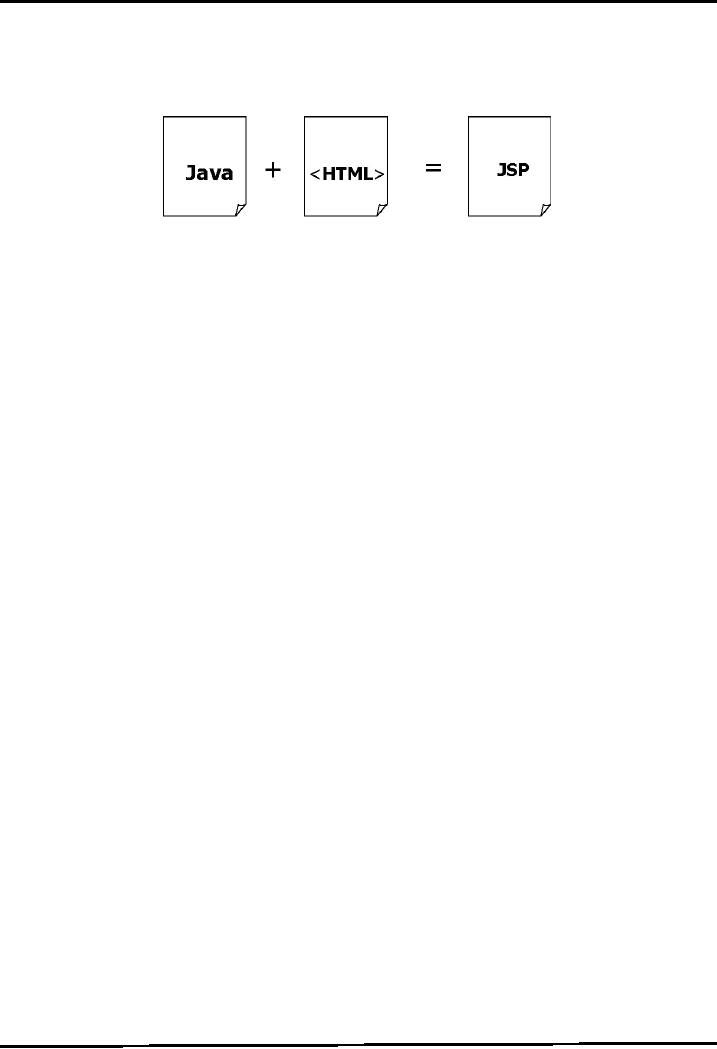
Web
Design & Development CS506
VU
--
Entire
JSP page gets translated
into a servlet (once), and servlet is
what actually gets
invoked
(for each request)
--
The
Java Server Pages technology
combine with Java code and
HTML tags in the same
document to
produce a JSP file.
Advantages of
JSP over Competing
Technologies
Versus
ASP or ColdFusion
--
JSPs
offer better language for
dynamic part i.e.
java
--
JSPs
are portable to multiple
servers and operating
systems
Versus
PHP
--
JSPs
offer better language for
dynamic part
--
JSPs
offer better tool
support
Versus pure
servlets
--
JSPs
provide more convenient way to
create HTML
--
JSPs
can use standard front
end tools (e.g.,
UltraDev)
--
JSPs
divide and conquer the problem of presentation and
business logic.
Setting
Up Your Environment
In
order to create a web-application
that entirely consists of
JSP pages and Html
based pages, the
setup
is
fairly simple as compared to a
servlet based
webapplication.
Set
your CLASSPATH.
No.
Compile
your code.
No.
Use
packages to avoid name
conflicts. No.
Put
JSP page in special directory,
like WEB-INF for servlets
No.
o
tomcat_install_dir/webapps/ROOT
o
jrun_install_dir/servers/default/default-app
Use
special URL to invoke JSP
page. No
However
o If
you want to use java
based classes in an application
along with JSPs, previous
rules
about
CLASSPATH, install dirs,
etc, still apply to regular
classes used by JSP
References:
Java
A Lab Course by Umair
Javed
Java
Package Tutorial by Patrick
Bouklee
http://jarticles.com/package/package_eng.html
JavaServer
Pages Overview
http://java.sun.com/products/jsp/overview.html
253
Table of Contents:
- JAVA FEATURES
- Java Virtual Machine & Runtime Environment
- Learning Basics of JAVA
- JAVA: Object Oriented Programming
- JAVA: Inheritance
- JAVA: Collections
- JAVA: Intro to Exceptions
- JAVA: Streams
- JAVA: Modification of Address Book Code
- JAVA: Graphical User Interfaces
- JAVA: Event Handling
- JAVA: More Examples of Handling Events
- JAVA: Problem in Last Code Example
- Java Database Connectivity
- JAVA: More on JDBC
- JAVA: Result Set
- JAVA: Meta Data
- Java Graphics
- JAVA: How to Animate
- JAVA Applets
- JAVA: Socket Programming
- JAVA: Serialization
- JAVA: Multithreading 1
- JAVA: Multithreading 2
- JAVA Web Application Development
- Java Servlets
- JAVA: Creating a Simple Web Application in Tomcat
- JAVA: Servlets Lifecycle
- JAVA: More on Servlets
- JAVA: Dispatching Requests
- JAVA: Session Tracking 1
- JAVA: Session Tracking 2
- JAVA: AddressBook Case Study Using Sevlets
- Java Server Pages 1
- JavaServer Pages 2
- Java Server Pages 3
- JAVA: JSP Action Elements and Scope
- JAVA: JSP Custom Tags
- JAVA: MVC + Case Study
- JAVA: MVC Model 2 Architecture
- JAVA: Layers and Tiers
- JAVA: Expression Language
- JAVA: JavaServer Pages Standard Tag Library (JSTL)
- JAVA: Client Side Validation & JavaServer Faces (JSF)
- JAVA: JavaServer Faces